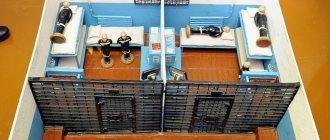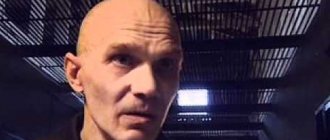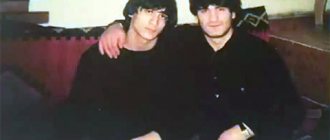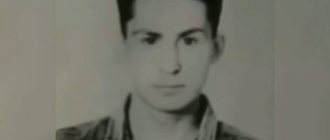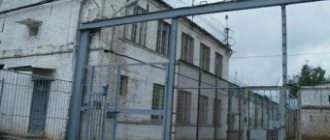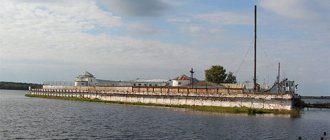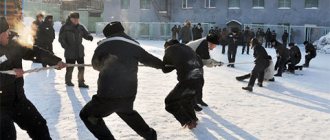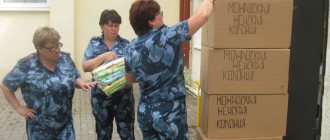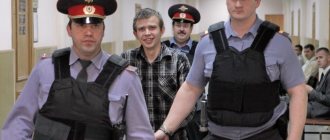White Swan Prison
White Swan is a special and strict regime colony. Throughout its existence, there has not been a single escape here.
White Swan is the unofficial name of a special regime correctional colony in the city of Solikamsk (the official name is VK-240/2 or IK-2 of the Federal Penitentiary Service of Russia in the Perm Territory). One of the toughest regimes in the correctional system. Variants of the unofficial name came from different versions: from the color of the walls, or, more plausibly, from the way prisoners moved around the prison: leaning forward (almost 90 degrees) with their arms thrown behind their backs, the so-called “swan”.
Prison "White Swan" in the city of Solikamsk
Or there is another version of the name from the fact that in the prison yard there is a monument to white swans. The famous terrorist Salman Raduev (died in 2002) and other especially dangerous criminals were kept in this prison. There are two famous zones in Russia that many have heard about. These are the Orenburg “Black Dolphin” and “White Swan”. It was this colony, located in the Perm region, that debunked the myth about the beautiful and free life of thieves in prison. Here, dozens, hundreds of thieves in law were broken and “uncrowned.”
Photo of the White Swan prison
Today, within these walls there is one of the Russian “life-long” zones, as well as strict and special regime colonies. In January 2008, the famous colony “BL”, as well as other colonies that in 1938 were part of the administration of the Usolsky camps, celebrated their 70th anniversary.
Crosses
The most famous prison on the banks of the Neva. Built at the end of the 19th century, the jail got its name due to its remarkable cruciform body. Only prominent figures and very influential people served sentences in Kresty. In the first years of the prison’s existence, Lev Gumilyov, Joseph Brodsky and a whole list of other notable personalities were imprisoned under the pretext of counter-revolutionary activities. Anna Akhmatova's husband and son were rotting in the dungeons of Krestov. Not far from the prison territory there is a monument dedicated to the poetess, on the slab of which lines from her “Requiem” are engraved, dedicated to the difficult fate of his wife and mother, whose closest and dearest people were imprisoned in the Crosses. After the fall of the Soviet Union, the prison was so overcrowded that small cells held 20 people. Those days are remembered for loud riots among prisoners. Years passed before Kresty was reformed, modernized and received the status of an elite, even with the prefix VIP, prison. Many prominent figures in the criminal world received unprecedented levels of comfort and privilege in prison.
Life sentence and no sweets
Camera. Photo: Website www.mzk1.ru
Each cell in Snezhinka is designed for four places, but so far there are only two people in them: there are not too many convicts in IK-6. Every day of prisoners is built according to a clear schedule: wake up at 6:00, bedtime at 22:00. Twice a week, prisoners can shower for 15 minutes. In their free time from work and walking, they can read, play chess or checkers, and also watch TV. Once a week, a movie show is held at Snezhinka.
Prisoners in IK-6 are fed three times a day; their diet consists of porridge, borscht, naval pasta, fish and stewed vegetables. Repeating the same dish is allowed no more than three times a week. Each prisoner in Snezhinka receives 90 grams of meat daily. Working in the kitchen and distributing food are 47 convicts convicted of petty crimes, who were specially brought to IK-6.
“Snezhinki” does not feed convicts sweets, but prisoners can order them themselves in the colony store. At the same time, each prisoner has a limit on purchases. For the first ten years of the term, it is a maximum of six thousand rubles, and then increases by another thousand. After 20 years behind bars, a convicted person can already spend 7.5 thousand rubles a month on purchases - of course, if he has this money.
Two decades behind bars provide another privilege - additional visits with relatives. If until 20 years of imprisonment, each prisoner is entitled to two short-term and two long-term meetings per year, then after 20 years, convicts receive the right to three visits with loved ones for four hours and three meetings lasting up to three days.
However, all this is only due to those convicts whose behavior the prison administration has no complaints about. Violators may not only be denied visits, but also sent to a punishment cell (punishment cell) for up to 60 days, or even transferred to a particularly strict prison regime. Convicts can stay there for up to three years.
The cells for repeat offenders are special: instead of ordinary beds, prisoners sleep in them on not very comfortable sun loungers, which are removed during the day and fastened to the wall. The convicts there are not entitled to any parcels, visits, or watching TV. However, so far there has not been a single prisoner in Snezhinka who would be thrown into a punishment cell for violations.
Sailor's silence
The name of the prison is due to its territorial location. In the past, even under Peter I, this area of Moscow was inhabited by workers from factories producing canvas, thick cotton, supplied for the navy of the Russian Empire under construction. Nearby were the residences of sailors who received serious injuries during legal proceedings and military campaigns. The combination of all the above facts was reflected in the immediate name of the prison: the name of the street plus the symbol of the almshouse in the form of the word “silence”. Prisoners with special status serve their sentences in this prison. For example, Khodorkovsky, who was recently released, served his sentence here. The legendary Sergei Mavrodi has become a real symbol and synonym of Sailor's Silence. And many other economic and political criminals were and remain prisoners of this prison.
WHERE DOES IT LIVE?
The black swan easily adapts to different conditions. This is the only swan living in Australia. With the exception of the mating season, it can be found throughout this continent. It feels great in places where there are bodies of water. During the nesting season, swans can be found near large, shallow freshwater lakes or other bodies of water. At other times, they often appear in sheltered sea bays, lagoons and on the seashore. Black swans fly beautifully. They can fly across the entire Australian continent, stopping near bodies of water. Under favorable conditions, flocks remain in one place throughout the year. The main thing is that there is enough food in these places and there are places convenient for making a nest. Black swans stop most willingly near shallow bodies of water.
Butyrka
Butyrka prison dates back to the times of Catherine II. In those years, the small Butyrsky farm, where military units were located, had its own prison, where state traitors and rebels were kept. Now such people are called extremists. The most famous rebel was Emelyan Pugachev, in whose honor one of the towers of the current prison is named. Nowadays, Butyrka has the status of the largest pre-trial detention center in the country. The prison does not have the best reputation among similar “institutions” regarding escapes. In Soviet times, escaped prisoners were not officially reported and such news was not disseminated, but in pre-revolutionary and post-Soviet times one often heard about escaped prisoners. Famous prisoners: Zhanna Aguzarova, Evgeny Ginzburg, Vyacheslav Datsik, Vladimir Mayakovsky, Felix Dzerzhinsky, Nestor Makhno and others.
The film "Red Swan" directed by Gu Rong: Stirlitz taught Chinese ballerinas to dance little swans
A choreographer performed by Vyacheslav Tikhonov teaches a Chinese ballerina how to dance the part in Swan Lake.
Photo: Personal archive
The film festival “17 Moments...” was held in the town of Pavlovsky Posad near Moscow. The highlight of this local film forum was the film “Red Swan” by Chinese director Gu Rong, in which Vyacheslav Tikhonov starred a quarter of a century ago. In China in the mid-90s, this film became a box office leader.
We have never seen such a scout before
Tikhonov’s daughter Anna accidentally remembered the painting when she discovered an advertising brochure at her dacha. In the photographs, Vyacheslav Vasilyevich is surrounded by Chinese ballerinas. He teaches some to do fouettés, and supports others’ legs. And he even seems to be showing the dance of little swans. Miracles! We definitely haven’t seen Stirlitz like this before.
The president of the Amur Autumn Film and Theater Festival, Sergei Novozhilov, helped find the director and his film. Through his Chinese partners, he found Gu Rong and invited him to a festival in Pavlovsky Posad, the homeland of Vyacheslav Vasilyevich. By the way, the film “Red Swan” will probably be shown in April at the international film festival in Moscow.
There is nothing surprising in the fact that in the early 90s Tikhonov went to Beijing to film. After the collapse of the USSR, everything in the country collapsed, including film production. Many Soviet actors gladly accepted invitations from foreign directors in order to somehow earn money. Vyacheslav Vasilyevich was invited to China to play the role of the Russian choreographer Gusev.
Vyacheslav Tikhonov gave his fawn hat, incredibly popular in the USSR, to the Chinese director as a souvenir.
Photo: Anastasia PLESHAKOVA
Photo of the artist instead of a pass
“Tikhonov is a very famous actor here,” director Gu Rong told me when we were sitting in a cafe in Pavlovsky Posad (our translator was a young Chinese woman who spoke decent Russian. - Author) “They know him from the films “Seventeen Moments of Spring ”, “War and Peace”, “White Bim Black Ear”, “They Fought for the Motherland”... Soviet film masterpieces were shown here with the same regularity as you have French cinema with Belmondo or Alain Delon. And your Pyotr Gusev (Russian choreographer played by Tikhonov) is almost a national hero for us. He staged the first ballet performances and was a teacher at the Beijing School. He stood at the origins of our national ballet.
— How did you meet Vyacheslav Tikhonov?
— The role of the Russian choreographer who came to China to create a ballet school had to be played by a Russian actor. Students of Pyotr Gusev told me that Vyacheslav Tikhonov and Pyotr Gusev are similar in appearance. And I went to Moscow to invite him to filming.
In the capital, officials from the Union of Cinematographers helped me arrange a meeting with Tikhonov. Frankly, I was very worried about how he would take my proposal. But he immediately agreed to come to China. In general, he was an amazing person - modest and open. He invited me to his dacha (Vyacheslav Tikhonov mainly lived at his dacha in Nikolina Gora. - Author). He showed me his house, then we went for a swim in the river that flows nearby (Moscow River - author). It felt like we had known each other for a long time...
Then my adventures began. I bought a puppy on Arbat. Setter, like White Bim Black Ear (in this film Tikhonov played the writer Ivan Ivanovich, Bim’s owner. - Author). I bought it, succumbing to a sentimental mood, but did not think through what I would do with this dog next. The Russian grandmother who sold the puppy assured me that the dog was very well-mannered. And she, and she was a bitch, squirted on my pillow in the hotel on the very first day. After that, I gave her the nickname Peng-Peng, which in Chinese means Stupid. I carried the puppy everywhere, even taking it with me to the Bolshoi Theater when I was invited to see Swan Lake. Where will I put Peng-Pen? In your bosom and into the theater: the Chinese ambassador helped us get into the stalls. But these were small difficulties... I arrived in Moscow by train and decided to return to Beijing the same way: I thought it would be easier with a dog. Not so! My puppy was “arrested” on the platform and was not allowed into the carriage. But I had a photograph with Tikhonov. And I explained to the head of the train that this is the dog of a famous Russian actor - look, he is in the photograph, Tikhonov is filming in China, and this dog must be delivered to him. Either Tikhonov’s fame helped me, or I was very convincing, but in the end the conductor let us into the carriage. And we got to Beijing without incident. My Peng-Pen lived with me for 14 years.
The film's touching finale: Tikhonov's hero and his student meet 40 years later.
Photo: Anastasia PLESHAKOVA
Fee: $5,000
— I wonder what kind of fee they offered Russian actors back then?
— Unfortunately, the fee was very modest, especially for an actor of such stature as Tikhonov. We paid him about $5,000. Some of the money had to be transferred through the Ministry of Foreign Affairs and the embassy after filming. Tikhonov, when he received the entire fee, sent me a letter of gratitude and wishes of every success.
It was filmed in Beijing over two weeks in 1992. Lived in the best hotel Kunlun.
Tikhonov brought a wig from Moscow. By the way, very good. Chinese posters appreciated it. The fawn hat with ear flaps, a mohair checkered scarf and a drape coat that he wore for filming are his personal belongings. He later gave me the hat.
He also came up with lines for his role. He was helped by Gusev's students, who remembered their teacher's favorite expressions. Once Tikhonov made a remark to our famous actor: they say that he is playing incorrectly. Too expressive, overbearing, it should be easier. Our luminary was not offended by Tikhonov - there are simply different acting traditions in China.
Pyotr Gusev was one of the founders of the ballet school in China. He is highly revered there. It is believed that he looks similar to Tikhonov.
Photo: RIA Novosti
WHAT THE MOVIE IS ABOUT
Intrigue, jealousy and the cultural revolution
The film covers the period from the mid-50s to the 90s of the last century. The life story of the first Chinese ballet dancers, who began dancing under the portrait of Mao Zedong. Russian dancer and choreographer Pyotr Gusev (Vyacheslav Tikhonov) comes to China to stage the ballet “Swan Lake”. He points out the shortcomings to the Chinese comrades. “You’re dancing not like a prince, but like a soldier with a rifle at the ready,” says Tikhonov. “And you treat your partner incorrectly: it’s a crystal vase, not a barbell.”
The main character is Gusev’s favorite student, young and talented. But there is also jealousy and intrigue in Chinese communist ballet. First, the heroine is dropped by her partner. Then, due to an injury, she was forced to quit classical dance. But she does not give up and switches to modern ballet - she stages the cult Chinese play “The Red Women's Detachment”.
The cultural revolution begins, and new suffering falls on the heroine’s head: she dances on the concrete floor barefoot, injures her leg again, loses her child, her husband leaves her... The only joy is a chance meeting 40 years later with the old teacher Gusev.
According to director Gu Rong, all the characters in his film are real people. And one of the dancers, who is the main villain in the film, took a high position in the Chinese Ministry of Culture.
Director Gu Rong was 33 years old when he began filming Red Swan.
Photo: Personal archive
HELP "KP"
Lepeshinskaya's favorite, Plisetskaya's partner
“Pyotr Andreevich Gusev deserves our memory,” says authoritative ballet expert Vadim Gaevsky. — This is a worthy representative of the Russian academic ballet school of the first half of the twentieth century. He played a key role in the restoration of Russian ballet after the revolution and the creation of a new Soviet ballet. And he himself was an outstanding, virtuoso artist. He had a bold jumping support, so he was the favorite of all ballerinas. They felt confident in his hands. Olga Lepeshinskaya adored him. He danced with Galina Ulanova and Maya Plisetskaya.
Extraordinarily bright, witty, educated, eloquent, and had a phenomenal memory.
Before traveling to China, Pyotr Gusev was the artistic director of the ballet of the theater. Kirov (today's Mariinsky Theater) and the Bolshoi Theater. In 1957 - 1961 - organizer of the ballet theater in China, was a choreographer and teacher at the Beijing School. In Beijing he staged Swan Lake, Corsair, Giselle and the first Chinese national ballet The Beauty of the Fish. To create a national ballet out of nothing, you need to be a real ascetic and educator!
White Swan
This is one of the most strict correctional institutions in Russia. Life here for prisoners is, to put it mildly, not sweet. True, we can say that it serves us right. After all, the inhabitants of the White Swan (Solikamsk colony) are murderers, rapists and others serving life sentences. The prison was founded in 1938. There are several options why the colony is popularly called the White Swan. The first of them is an option with images of white swans installed on the territory. The second is an analogy with how prisoners move around the territory of the colony - in the “swan” pose, i.e. bending at 90 degrees and raising his handcuffed hands high. On the territory of this prison there are practically no concepts of authority and “cool”. Character and health are destroyed instantly here. The famous field commander of the Chechen gang formations, Salman Raduev, was convinced of this the hard way. He lived in the White Swan for only a few months, after which he died under mysterious circumstances.
REPRODUCTION
The nesting time of black swans depends on the rainy season - in different regions of Australia it begins at different times. In the state of Queensland, in the northeast of the mainland, the mating season sometimes begins as early as February, and in western Australia - only in August. During prolonged drought, swans do not nest at all. The black swan builds a large nest, the diameter of which can reach one meter or more. To do this, he chooses a place located close to the water. One side of the nest almost touches the water. Sometimes a black swan nests in swamps or builds a floating nest from plant material it finds in the water. Unlike other species, these birds are tolerant of fellow birds. Sometimes these swans nest in colonies of more than 1000 pairs. The female lays the first light green egg after completing the construction of the nest, and only then lays others. Partners take turns incubating them for 35-45 days. Incubation begins with the laying of the first egg, so the chicks hatch at intervals of 2-3 days. Almost immediately after hatching, the chicks leave the nest and, under the supervision of one of the parents, go down to the water. The female usually remains in the nest until all the chicks have hatched. When the last one appears, the whole family meets on the water. Young black swans will begin to fly no earlier than 3.5 months.
Black Dolphin
Perhaps the toughest place to imprison criminals. Compared to the Black Dolphin, the White Swan is a sanatorium for relaxation. After all, in White Swan there is even a library for prisoners. Life-sentenced prisoners are serving their sentences in Black Dolphin. These are rapists and murderers. Cells for prisoners are like a cage within a cage: both the window and the door are fenced with a special metal grill, reducing the space of the cell and depriving the prisoner of the banal opportunity to look out the window. The prisoner is moved blindfolded under an escort of three guards and one dog handler. The colony received its name from the pretty image of a black dolphin installed on its territory. Again, the laws of thieves practically do not apply in prisons of this kind. A rabid bandit and crime boss can easily be put in the same cell with a rapist and murderer. Not a single escape, not a single attempt.
Description of the species
Black swans became known to Europeans only after the discovery of Australia and Tasmania. This is where this beautiful and exotic bird comes from. After the discovery of New Zealand, black swans came to these islands, where they became incredibly popular in private backyards and parks.
The black plumage of birds has a peculiar moire pattern created by the grayish edging of the outer feather.
Some birds have interspersed white or even black and white feathers. It is very common to find representatives of this species with curled flight feathers and shoulder feathers. The beak is bright scarlet. The feet are most often black or blue-black. The young are distinguished by their grayish-brown feather color and light, often pink, beak.
The black swan is a rather large bird. The weight of individual representatives can reach ten kilograms or more, and the wingspan is about two meters. The body length of females does not exceed 110 cm, males - 150 cm.
Representatives of this species have the longest neck among all their relatives, a neat small head and a short, dense tail. The length and structure of the neck allows it to reach food even from great depths.
INTERESTING FACTS, INFORMATION…
- Most species of swans have white plumage: for example, the mute swan. The black-necked swan has a white body, and only its neck and head are black.
- Often during the nesting season you can see a nest with chicks floating on the surface of the lake. The black swan usually attaches its nest to coastal vegetation, but sometimes it detaches from it and swims away.
- Black swans usually fly at night. The flock flies at high altitude in a clearly organized order. The trumpet sounds they make are very well audible even at a very long distance.
- Black swans were brought to Europe in the mid-18th century. In England they have long been considered harbingers of trouble. The reason for this superstition is the black plumage of birds.
WHAT DOES IT EAT?
The black swan feeds almost exclusively on plants and only occasionally eats insects and other invertebrates. It obtains food at the bottom, plunging into the water, while its tail rises upward.
This swan has a long neck, so it is convenient for him to explore the bottom. But this is only possible in shallow water, so birds cannot feed in deep places. The swan takes out the rhizomes of aquatic plants from the bottom. Near the shore, the black swan walks in shallow water and eats the green parts of all the plants that its long neck can reach. His favorite delicacy is duckweed. Sometimes birds look for food far from the water, usually in fields, where they nibble young shoots with great appetite, since birds cannot feed at great depths. That's why farmers don't like these beautiful birds.
